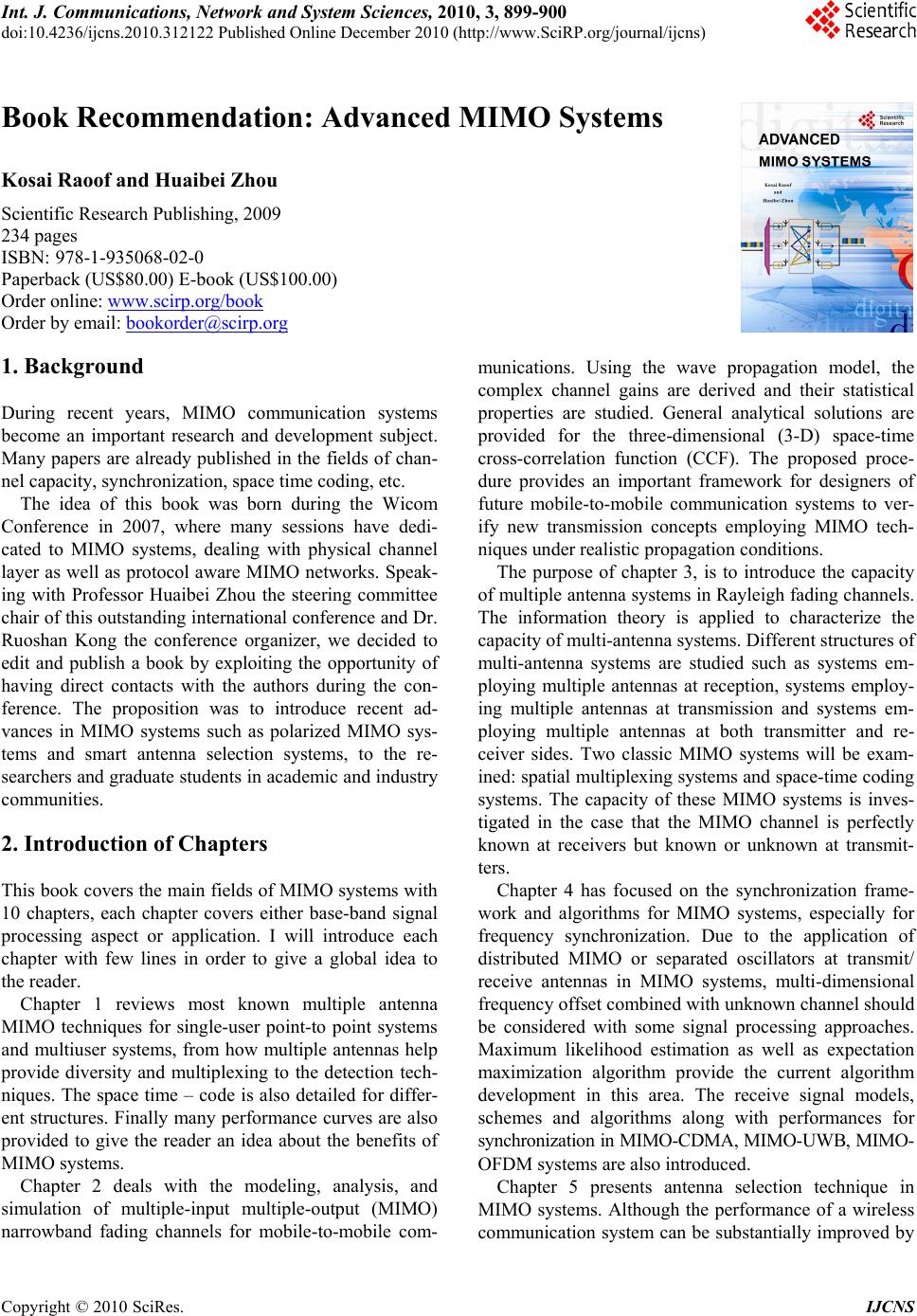
Int. J. Communications, Network and System Sciences, 2010, 3, 899-900
doi:10.4236/ijcns.2010.312122 Published Online December 2010 (http://www.SciRP.org/journal/ijcns)
Copyright © 2010 SciRes. IJCNS
899
Book Recommendation: Advanced MIMO Systems
Kosai Raoof and Huaibei Zhou
Scientific Research Publishing, 2009
234 pages
ISBN: 978-1-935068-02-0
Paperback (US$80.00) E-b oo k (US $100.00)
Order online: www.scirp.org/book
Order by email: bookorder@scirp.org
1. Background
During recent years, MIMO communication systems
become an important research and development subject.
Many papers are already published in the fields of chan-
nel capacity, synchronization, space time coding, etc.
The idea of this book was born during the Wicom
Conference in 2007, where many sessions have dedi-
cated to MIMO systems, dealing with physical channel
layer as well as protocol aware MIMO networks. Speak-
ing with Professor Huaibei Zhou the steering committee
chair of this outstanding international conference and Dr.
Ruoshan Kong the conference organizer, we decided to
edit and publish a book by exploiting the opportunity of
having direct contacts with the authors during the con-
ference. The proposition was to introduce recent ad-
vances in MIMO systems such as polarized MIMO sys-
tems and smart antenna selection systems, to the re-
searchers and graduate students in academic and industry
communities.
2. Introduction of Chapters
This book covers the main fields of MIMO systems with
10 chapters, each chapter covers either base-band signal
processing aspect or application. I will introduce each
chapter with few lines in order to give a global idea to
the reader.
Chapter 1 reviews most known multiple antenna
MIMO techniques for single-user point-to point systems
and multiuser systems, from how multiple antennas help
provide diversity and multiplexing to the detection tech-
niques. The space time – code is also detailed for differ-
ent structures. Finally many performance curves are also
provided to give the reader an idea about the benefits of
MIMO systems.
Chapter 2 deals with the modeling, analysis, and
simulation of multiple-input multiple-output (MIMO)
narrowband fading channels for mobile-to-mobile com-
munications. Using the wave propagation model, the
complex channel gains are derived and their statistical
properties are studied. General analytical solutions are
provided for the three-dimensional (3-D) space-time
cross-correlation function (CCF). The proposed proce-
dure provides an important framework for designers of
future mobile-to-mobile communication systems to ver-
ify new transmission concepts employing MIMO tech-
niques under realistic propagation conditions.
The purpose of chapter 3, is to introduce the capacity
of multiple antenna systems in Rayleigh fading channels.
The information theory is applied to characterize the
capacity of multi-antenna systems. Different structures of
multi-antenna systems are studied such as systems em-
ploying multiple antennas at reception, systems employ-
ing multiple antennas at transmission and systems em-
ploying multiple antennas at both transmitter and re-
ceiver sides. Two classic MIMO systems will be exam-
ined: spatial mu ltiplexing systems and sp ace-time coding
systems. The capacity of these MIMO systems is inves-
tigated in the case that the MIMO channel is perfectly
known at receivers but known or unknown at transmit-
ters.
Chapter 4 has focused on the synchronization frame-
work and algorithms for MIMO systems, especially for
frequency synchronization. Due to the application of
distributed MIMO or separated oscillators at transmit/
receive antennas in MIMO systems, multi-dimensional
frequency offset combined with unknown channel should
be considered with some signal processing approaches.
Maximum likelihood estimation as well as expectation
maximization algorithm provide the current algorithm
development in this area. The receive signal models,
schemes and algorithms along with performances for
synchron ization in MIMO-CDMA , MIMO-UW B, MIMO-
OFDM systems are also introduced.
Chapter 5 presents antenna selection technique in
MIMO systems. Although the performance of a wireless
communication system can be substantially improved by